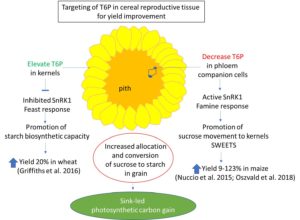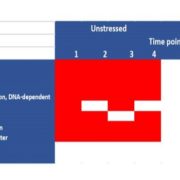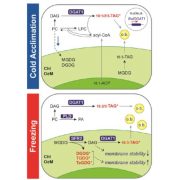Update: The role of trehalose 6-phosphate in crop yield and resilience
By Matthew J. Paul, Asier Gonzalez-Uriarte, Cara A. Griffiths, and Keywan Hassani-Pak
 Significant increases in global food security require improving crop yields in favourable and poor conditions alike. However, it is challenging to increase both the crop yield potential and yield resilience simultaneously, since the mechanisms that determine productivity and stress tolerance are typically inversely related. Carbon allocation and use may be amenable to improving yields in a range of conditions. The interaction between trehalose 6-phosphate (T6P) and SnRK1 (SNF1-related/AMPK protein kinases) significantly affects the regulation of carbon allocation and utilisation in plants. Targeting T6P appropriately to certain cell types, tissue types, and developmental stages results in an increase in both yield potential and resilience. Increasing T6P levels promotes flux through biosynthetic pathways associated with growth and yield, whereas decreasing T6P levels promotes mobilisation of carbon reserves and movement of carbon associated with stress responses. Genetic modification, gene discovery through QTL mapping, and chemical intervention approaches have been used to modify the T6P pathway and improve crop performance under favourable conditions, drought, and flooding in the three main food security crops: wheat (Triticum aestivum), maize (Zea mays), and rice (Oryza sativa). Interestingly, both trehalose phosphate synthase (TPS) and trehalose phosphate phosphatase (TPP) genes are associated with maize domestication. A phylogenetic comparison of wheat TPS and TPP with eudicots and other cereals shows strong distinctions in wheat in both gene families. This update highlights recent research examining the potential of the trehalose pathway in crop improvement, and highlights an emerging strategy to increase cereal yields by targeting T6P in reproductive tissue.
Significant increases in global food security require improving crop yields in favourable and poor conditions alike. However, it is challenging to increase both the crop yield potential and yield resilience simultaneously, since the mechanisms that determine productivity and stress tolerance are typically inversely related. Carbon allocation and use may be amenable to improving yields in a range of conditions. The interaction between trehalose 6-phosphate (T6P) and SnRK1 (SNF1-related/AMPK protein kinases) significantly affects the regulation of carbon allocation and utilisation in plants. Targeting T6P appropriately to certain cell types, tissue types, and developmental stages results in an increase in both yield potential and resilience. Increasing T6P levels promotes flux through biosynthetic pathways associated with growth and yield, whereas decreasing T6P levels promotes mobilisation of carbon reserves and movement of carbon associated with stress responses. Genetic modification, gene discovery through QTL mapping, and chemical intervention approaches have been used to modify the T6P pathway and improve crop performance under favourable conditions, drought, and flooding in the three main food security crops: wheat (Triticum aestivum), maize (Zea mays), and rice (Oryza sativa). Interestingly, both trehalose phosphate synthase (TPS) and trehalose phosphate phosphatase (TPP) genes are associated with maize domestication. A phylogenetic comparison of wheat TPS and TPP with eudicots and other cereals shows strong distinctions in wheat in both gene families. This update highlights recent research examining the potential of the trehalose pathway in crop improvement, and highlights an emerging strategy to increase cereal yields by targeting T6P in reproductive tissue.








